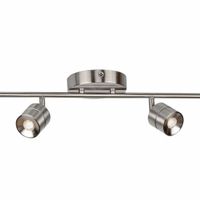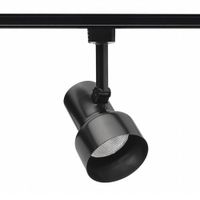Call +(254) 703 030 000 / 751 483 999 / 721 704 777
- Home
- Lighting
- Lighting Fixtures Retrofit Kits
- Track Lighting
Track Lighting
Track lighting serves as an accent light or spot light to illuminate small spaces, highlight product displays or decorative features, and brighten corners and alcoves. It consists of light heads spaced along a rail that mounts to a ceiling, wall, beam, or other surface. The heads swivel or pivot to .....Read More
Frequently Asked Questions
What is track lighting used for?
Track lighting is used for providing versatile and adjustable illumination in various settings. It consists of a track that is mounted to the ceiling or wall, with multiple light fixtures attached to it. These fixtures can be repositioned along the track, allowing for customizable lighting solutions.
Track lighting is commonly used in residential, commercial, and retail environments. In homes, it is often installed in kitchens, living rooms, or hallways to highlight artwork, architectural features, or specific areas like countertops and reading nooks. Its flexibility makes it ideal for spaces that require focused lighting or where the layout may change over time.
In commercial settings, track lighting is used to enhance the ambiance and functionality of spaces such as offices, galleries, and showrooms. It can be directed to spotlight products, artwork, or displays, creating an inviting and dynamic atmosphere. Retail stores often use track lighting to draw attention to merchandise, making it more appealing to customers.
Track lighting is also favored for its modern aesthetic and ability to provide both task and ambient lighting. It can be equipped with various types of bulbs, including LED, halogen, or incandescent, to achieve different lighting effects and energy efficiencies. Additionally, track lighting systems can be dimmable, offering further control over the lighting environment.
Overall, track lighting is valued for its adaptability, ease of installation, and ability to enhance the visual appeal and functionality of a space.
How do you install track lighting?
1. **Turn Off Power**: Switch off the power to the existing light fixture at the circuit breaker to ensure safety.
2. **Remove Existing Fixture**: Detach the current light fixture by unscrewing it and disconnecting the wires.
3. **Install Mounting Plate**: Attach the mounting plate of the track lighting system to the electrical box using screws. Ensure it is securely fastened.
4. **Connect Wires**: Match the wires from the track lighting to the wires in the ceiling. Typically, connect black to black (hot), white to white (neutral), and green or bare copper to the ground wire. Use wire nuts to secure the connections.
5. **Attach Track**: Secure the track to the mounting plate. Align the track with the mounting plate and use screws to fasten it in place. Ensure it is level and properly aligned.
6. **Install End Cap**: Place the end cap on the open end of the track to cover the exposed wiring.
7. **Insert Light Fixtures**: Attach the light fixtures to the track. Insert the connector into the track and twist or lock it into place according to the manufacturer's instructions.
8. **Adjust Fixtures**: Position the light fixtures along the track as desired. Adjust the direction of the lights to focus on specific areas.
9. **Restore Power**: Turn the power back on at the circuit breaker and test the track lighting to ensure it is functioning correctly.
10. **Final Adjustments**: Make any necessary adjustments to the positioning of the lights for optimal illumination.
Always follow the manufacturer's instructions and local electrical codes. If unsure, consult a professional electrician.
Can track lighting be used in residential settings?
Yes, track lighting can be used in residential settings. It offers flexibility, modern aesthetics, and functionality, making it suitable for various rooms in a home. Track lighting consists of a series of light fixtures attached to a continuous track, allowing for adjustable positioning and direction of light. This adaptability makes it ideal for highlighting artwork, illuminating specific areas, or providing general lighting.
In living rooms, track lighting can create a focal point by accentuating architectural features or artwork. In kitchens, it provides task lighting over countertops and islands, enhancing visibility for cooking and food preparation. In bedrooms, it can serve as ambient lighting or spotlight specific areas like reading nooks.
Track lighting is available in various styles, finishes, and sizes, allowing homeowners to choose options that complement their interior design. It can be installed on ceilings or walls, and some systems are compatible with smart home technology, offering dimming and color-changing capabilities.
Installation is relatively straightforward, often requiring only a single electrical junction box, which reduces the need for extensive wiring. This makes it a cost-effective option for renovations or updates.
Overall, track lighting is a versatile and stylish choice for residential settings, offering both functional and decorative benefits.
What are the benefits of using track lighting?
Track lighting offers several benefits, making it a popular choice for both residential and commercial spaces. Firstly, it provides flexibility in lighting design. The track system allows for the repositioning of individual light fixtures, enabling users to direct light precisely where needed. This adaptability is ideal for highlighting artwork, architectural features, or specific areas within a room.
Secondly, track lighting is versatile in style and function. It can accommodate various types of light fixtures, including spotlights, pendants, and floodlights, allowing for a customized lighting scheme that suits different aesthetic preferences and functional requirements.
Thirdly, track lighting is relatively easy to install. It requires only a single electrical junction box, reducing the need for extensive wiring and making it a cost-effective option for renovations or new installations. This simplicity also means that it can be easily modified or expanded as lighting needs change.
Additionally, track lighting is energy-efficient. Many track lighting systems are compatible with LED bulbs, which consume less electricity and have a longer lifespan compared to traditional incandescent bulbs. This efficiency translates to lower energy bills and reduced environmental impact.
Moreover, track lighting can enhance the ambiance of a space. By adjusting the direction and intensity of the light, users can create different moods and atmospheres, from bright and focused to soft and ambient.
Finally, track lighting is space-saving. It is mounted on the ceiling, freeing up floor and wall space, which is particularly beneficial in smaller rooms or areas with limited space.
Overall, track lighting combines functionality, style, and efficiency, making it a practical and attractive lighting solution for various settings.
How do you choose the right track lighting system?
To choose the right track lighting system, consider the following factors:
1. **Purpose and Functionality**: Determine the primary purpose of the lighting. Is it for ambient, task, or accent lighting? This will guide the type and number of fixtures needed.
2. **Track Type**: Choose between H, J, or L track systems, which are the most common. Ensure compatibility with existing fixtures if you're adding to an existing system.
3. **Layout and Space**: Assess the room's layout and size. Measure the area to decide the track length and configuration (straight, L-shaped, U-shaped, or custom).
4. **Ceiling Type**: Consider the ceiling height and type. High ceilings may require adjustable or pendant fixtures, while low ceilings might benefit from flush-mounted options.
5. **Fixture Style**: Select fixtures that complement your interior design. Options range from modern and sleek to traditional and ornate.
6. **Light Bulb Type**: Decide on the type of bulbs (LED, halogen, incandescent) based on energy efficiency, brightness, and color temperature preferences.
7. **Dimming Capability**: If you want adjustable lighting levels, ensure the system is compatible with dimmer switches.
8. **Power Source and Installation**: Determine the power source location and whether you need a plug-in or hardwired system. Consider professional installation for complex setups.
9. **Budget**: Set a budget that includes the cost of tracks, fixtures, bulbs, and installation. Balance quality with affordability.
10. **Brand and Quality**: Research brands known for durability and quality. Read reviews and seek recommendations.
11. **Future Flexibility**: Choose a system that allows for easy adjustments or additions in the future.
By considering these factors, you can select a track lighting system that meets your functional needs and aesthetic preferences.
Can you mix and match track light heads and pendants?
Yes, you can mix and match track light heads and pendants, provided they are compatible with the track system you are using. Track lighting systems come in different types, such as H, J, and L tracks, and each type has its own specific connectors and fittings. To successfully mix and match, ensure that the track heads and pendants you choose are designed for the same track type.
When mixing and matching, consider the following:
1. **Compatibility**: Verify that the track heads and pendants are compatible with the track system. This includes checking the voltage and connector type.
2. **Design and Style**: Choose fixtures that complement each other in terms of design and style. Mixing different styles can create a unique look, but they should still harmonize with the overall decor of the space.
3. **Functionality**: Consider the purpose of each light. Track heads are typically used for directional lighting, while pendants can provide ambient or task lighting. Ensure that the combination meets your lighting needs.
4. **Weight and Size**: Ensure that the track can support the weight of the pendants, especially if they are heavier than standard track heads. Also, consider the size of the fixtures to avoid overcrowding the track.
5. **Aesthetics**: Mixing different finishes and colors can add visual interest, but maintain a cohesive look by sticking to a consistent theme or color palette.
By paying attention to these factors, you can effectively mix and match track light heads and pendants to create a versatile and stylish lighting solution.
How do you maintain and clean track lighting fixtures?
To maintain and clean track lighting fixtures, follow these steps:
1. **Safety First**: Turn off the power to the track lighting at the circuit breaker to ensure safety. Allow the bulbs to cool down if they were recently on.
2. **Remove Bulbs**: Carefully remove the bulbs from the fixtures. Handle them with a cloth or gloves to avoid oils from your skin transferring to the bulbs, which can cause hot spots and reduce their lifespan.
3. **Dusting**: Use a microfiber cloth or a duster to remove dust from the track and fixtures. For hard-to-reach areas, a vacuum with a brush attachment can be effective.
4. **Cleaning the Track**: Wipe the track with a damp cloth to remove any grime or residue. Ensure the cloth is not too wet to prevent moisture from entering the electrical components.
5. **Cleaning Fixtures**: For glass or metal fixtures, use a mild detergent mixed with water. Dip a cloth in the solution, wring it out, and gently clean the fixtures. Avoid abrasive cleaners that can scratch surfaces.
6. **Inspect for Damage**: Check for any signs of wear or damage, such as frayed wires or loose connections. Replace any damaged parts as necessary.
7. **Reassemble**: Once everything is clean and dry, reassemble the fixtures and replace the bulbs. Ensure they are securely fastened.
8. **Test**: Turn the power back on and test the lights to ensure they are functioning correctly.
9. **Regular Maintenance**: Schedule regular cleaning every few months to prevent dust buildup and maintain optimal lighting performance.
By following these steps, you can keep your track lighting fixtures clean and in good working condition, enhancing both their longevity and the quality of light they provide.


